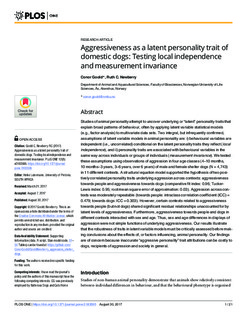| dc.contributor.author | Goold, Conor Michael | |
| dc.contributor.author | Newberry, Ruth C. | |
| dc.date.accessioned | 2017-12-01T10:12:31Z | |
| dc.date.available | 2017-12-01T10:12:31Z | |
| dc.date.created | 2017-09-25T00:08:09Z | |
| dc.date.issued | 2017 | |
| dc.identifier.citation | PLoS ONE. 2017, 12 (8), e0183595-?. | nb_NO |
| dc.identifier.issn | 1932-6203 | |
| dc.identifier.uri | http://hdl.handle.net/11250/2468722 | |
| dc.description.abstract | Studies of animal personality attempt to uncover underlying or “latent” personality traits that explain broad patterns of behaviour, often by applying latent variable statistical models (e.g., factor analysis) to multivariate data sets. Two integral, but infrequently confirmed, assumptions of latent variable models in animal personality are: i) behavioural variables are independent (i.e., uncorrelated) conditional on the latent personality traits they reflect (local independence), and ii) personality traits are associated with behavioural variables in the same way across individuals or groups of individuals (measurement invariance). We tested these assumptions using observations of aggression in four age classes (4–10 months, 10 months–3 years, 3–6 years, over 6 years) of male and female shelter dogs (N = 4,743) in 11 different contexts. A structural equation model supported the hypothesis of two positively correlated personality traits underlying aggression across contexts: aggressiveness towards people and aggressiveness towards dogs (comparative fit index: 0.96; Tucker-Lewis index: 0.95; root mean square error of approximation: 0.03). Aggression across contexts was moderately repeatable (towards people: intraclass correlation coefficient (ICC) = 0.479; towards dogs: ICC = 0.303). However, certain contexts related to aggressiveness towards people (but not dogs) shared significant residual relationships unaccounted for by latent levels of aggressiveness. Furthermore, aggressiveness towards people and dogs in different contexts interacted with sex and age. Thus, sex and age differences in displays of aggression were not simple functions of underlying aggressiveness. Our results illustrate that the robustness of traits in latent variable models must be critically assessed before making conclusions about the effects of, or factors influencing, animal personality. Our findings are of concern because inaccurate “aggressive personality” trait attributions can be costly to dogs, recipients of aggression and society in general. | nb_NO |
| dc.language.iso | eng | nb_NO |
| dc.relation.uri | https://doi.org/10.1371/journal.pone.0183595 | |
| dc.rights | Attribution-NonCommercial-NoDerivatives 4.0 Internasjonal | * |
| dc.rights.uri | http://creativecommons.org/licenses/by-nc-nd/4.0/deed.no | * |
| dc.subject | Dyreatferd | nb_NO |
| dc.subject | Animal Behaviour | nb_NO |
| dc.subject | Dyr/menneskeinteraksjoner | nb_NO |
| dc.subject | Human-animal interactions | nb_NO |
| dc.subject | Psykometri / anvendt statistikk | nb_NO |
| dc.subject | Psychometrics / Applied statistics | nb_NO |
| dc.subject | Etologi | nb_NO |
| dc.subject | Ethology | nb_NO |
| dc.title | Aggressiveness as a latent personality trait of domestic dogs: testing measurement invariance and local independence | nb_NO |
| dc.type | Journal article | nb_NO |
| dc.type | Peer reviewed | nb_NO |
| dc.description.version | acceptedVersion | nb_NO |
| dc.description.version | publishedVersion | nb_NO |
| dc.subject.nsi | VDP::Landbruksfag: 910 | nb_NO |
| dc.subject.nsi | VDP::Agricultural sciences: 910 | nb_NO |
| dc.source.pagenumber | e0183595-? | nb_NO |
| dc.source.volume | 12 | nb_NO |
| dc.source.journal | PLoS ONE | nb_NO |
| dc.source.issue | 8 | nb_NO |
| dc.identifier.doi | 10.1371/journal.pone.0183595 | |
| dc.identifier.cristin | 1497449 | |
| dc.relation.project | Universitetet for miljø- og biovitenskap: PhD scholarship | nb_NO |
| cristin.unitcode | 192,10,1,0 | |
| cristin.unitname | Institutt for husdyr- og akvakulturvitenskap | |
| cristin.ispublished | true | |
| cristin.fulltext | postprint | |
| cristin.fulltext | original | |
| cristin.qualitycode | 1 | |

